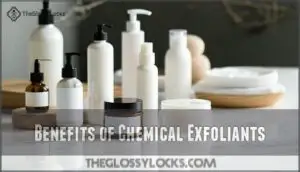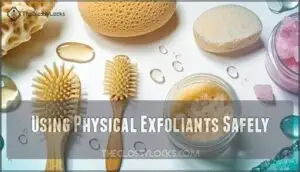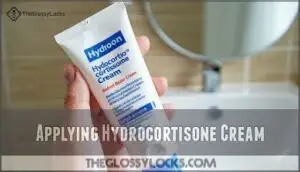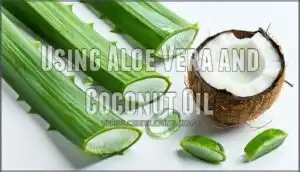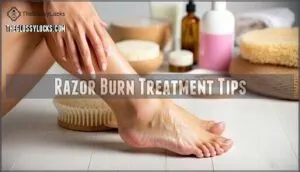This site is supported by our readers. We may earn a commission, at no cost to you, if you purchase through links.
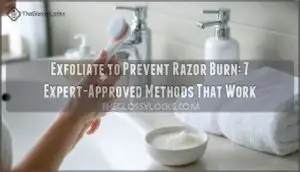 When you exfoliate to prevent razor burn, you’re clearing the path for a smoother shave. Dead skin cells can trap hair and cause irritation, so gentle exfoliation 2-3 times per week keeps your skin ready.
When you exfoliate to prevent razor burn, you’re clearing the path for a smoother shave. Dead skin cells can trap hair and cause irritation, so gentle exfoliation 2-3 times per week keeps your skin ready.
Use a mild scrub or chemical exfoliant with salicylic acid before shaving. This removes buildup and lifts ingrown hairs that often trigger razor burn.
Think of it as prepping a canvas before painting—you want a clean, smooth surface. Always exfoliate before shaving, not after, since freshly shaved skin is too sensitive.
The right exfoliation method depends on your skin type and the area you’re treating, and it’s essential to find a method that works for you to achieve a clean surface.
Table Of Contents
- Key Takeaways
- Prevent Razor Burn
- Exfoliate Before Shaving
- 7 Best Exfoliants for Razor Burn
- Soothing Razor Burn
- Razor Burn Treatment Tips
- Frequently Asked Questions (FAQs)
- Does exfoliating help prevent razor burn?
- How do you prevent razor burn?
- What can I use to exfoliate my skin before shaving?
- How to exfoliate down there before shaving?
- How often should I exfoliate between shaves?
- Can I exfoliate immediately after getting razor burn?
- Whats the difference between AHA and BHA exfoliants?
- Should I exfoliate differently for face vs body?
- When is the best time to exfoliate during shower?
- Conclusion
Key Takeaways
- Exfoliate 2-3 times weekly before shaving – You’ll remove dead skin cells that trap hairs and cause irritation, creating a smooth surface for your razor to glide across without dragging or catching.
- Choose the right exfoliant for your skin type – You can use gentle chemical exfoliants with salicylic acid for sensitive skin, or physical scrubs for tougher areas, but never exfoliate freshly shaved or irritated skin.
- Time your exfoliation properly – You should exfoliate before shaving, not after, since your skin needs that clean surface for the smoothest shave and your post-shave skin is too sensitive for scrubbing.
- Combine exfoliation with proper shaving technique – You’ll get the best results when you pair regular exfoliation with sharp blades, light pressure, and shaving in the direction of hair growth to prevent razor burn completely.
Prevent Razor Burn
You can prevent razor burn by understanding what causes it and taking steps to protect your skin before, during, and after shaving.
Proper exfoliation removes dead skin cells that clog your razor, while correct shaving techniques reduce friction and irritation that lead to those painful red bumps and stinging sensations, which can be alleviated by proper techniques.
Understanding Razor Burn Causes
Razor burn strikes when friction and irritation team up against your skin.
When your razor becomes your skin’s worst enemy, friction and irritation join forces to create the perfect storm.
Understanding what triggers this uncomfortable condition helps you dodge the burn before it happens.
Here are the main culprits behind razor burn:
- Blade dullness – Dull razors drag across skin instead of cutting cleanly, creating micro-tears and inflammation
- Shaving frequency – Daily shaving doesn’t give sensitive skin time to recover between sessions
- Hair type – Coarse or curly hair requires more pressure, increasing skin sensitivity and irritation risk
Importance of Exfoliation
Dead skin can block razors, causing irritation and painful bumps.
Exfoliation benefits your skin by removing this barrier, promoting smoothness and preventing razor burn. It also boosts skin cell turnover and product absorption, creating the ideal surface for shaving.
You’ll minimize ingrowns, maintain healthy skin, and enjoy a closer shave.
| Benefit | How it Helps | Example Tools | Frequency |
|---|---|---|---|
| Smoothness | Clears dead skin | Sugar Scrubs | Weekly |
| Ingrown Prevention | Frees trapped hairs | Chemical Exfoliants | 2-3x per week |
| Skin Health | Boosts regeneration | AHA/BHA Body Wash | Daily |
| Shaving Preparation | Enhances glide | Gentle Skin Brushes | Pre-shave use |
Shaving Techniques for Sensitive Skin
When shaving sensitive skin, gentle pressure makes all the difference.
Use light, feather-touch strokes rather than pressing hard—your razor should glide, not scrape.
Choose single-blade or cartridge razors over multi-blade options to reduce irritation.
Shave every other day instead of daily, allowing your skin recovery time.
Consider using electric options for sensitive skin needs.
Proper skin hydration before shaving and a soothing aftercare routine complete your gentle approach.
Exfoliate Before Shaving
Think of exfoliation as clearing the runway before takeoff—you’re removing dead skin cells and debris that can clog your razor and cause irritation during shaving.
When you exfoliate properly before picking up that razor, you create a smooth surface that allows for a cleaner shave while substantially reducing your chances of developing painful razor burn and those annoying ingrown hairs.
Benefits of Chemical Exfoliants
Chemical exfoliants offer gentle exfoliation without the harsh scrubbing that can worsen razor burn.
These acids work beneath the surface to promote skin cell turnover, making your preventative care routine more effective against irritation.
- AHA and BHA chemical types dissolve dead skin cells that clog razors and cause bumps
- Enhanced skin exfoliation unclogs pores more thoroughly than physical scrubs
- Long-term benefits include reduced hyperpigmentation and smoother skin care results
- Chemical exfoliants shaving preparation creates ideal conditions for razor burn prevention
Consider using AHA BHA exfoliants for superior results.
Using Physical Exfoliants Safely
Physical exfoliants can work wonders when you master the right scrubbing technique. Apply gentle, circular motions with light pressure control—your skin isn’t a dirty pot that needs aggressive scrubbing.
Keep your exfoliation tools clean through proper tool hygiene. Many users find success with various exfoliation products.
Always assess your skin sensitivity first, then follow with thorough post-exfoliation care. This gentle exfoliation method prepares your skin perfectly for shaving and ensures a smooth finish with proper post-exfoliation care.
Exfoliating Sensitive Areas
Sensitive areas like your bikini line and underarms need extra TLC regarding preshave exfoliation.
Use gentle exfoliation methods with softer pressure and milder products than you’d use elsewhere, and for bikini line shaving and underarm shaving tips, try chemical exfoliants over scrubs.
Frequency matters too—limit exfoliation to twice weekly for sensitive skin areas.
7 Best Exfoliants for Razor Burn
Choosing the right products can make all the difference between smooth, comfortable skin and painful razor burn that lasts for days.
These seven expert-recommended exfoliants and post-shave treatments work by removing dead skin cells, reducing inflammation, and creating a protective barrier that helps your skin recover faster from shaving irritation.
1. eos Sensitive Skin Shaving Cream
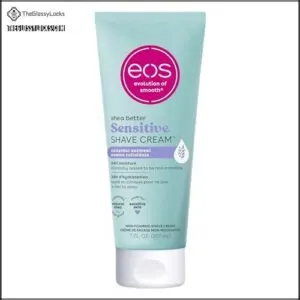
First in our lineup of gentle exfoliants, eos Sensitive Skin Shaving Cream delivers clinically-tested, non-irritating care that your skin will thank you for.
This fragrance-free formula contains colloidal oatmeal to soothe and protect while you shave, making it perfect for those who’ve battled razor burn before.
You’ll get 24-hour hydration that keeps skin smooth long after shaving.
The cream works like a gentle bodyguard, creating a protective barrier that prevents irritation while helping your razor glide effortlessly across sensitive areas.
Best For: Individuals with sensitive skin looking for a fragrance-free shaving cream that provides soothing hydration and prevents irritation.
- Clinically-tested, non-irritating formula with colloidal oatmeal.
- Provides 24-hour hydration for smooth and moisturized skin.
- Fragrance-free and ideal for preventing razor burn.
- May not lather like traditional shaving foams.
- Limited to individuals who prefer fragrance-free products.
- Requires additional rinsing if not used as a leave-on moisturizer.
2. Aquaphor Healing Ointment Dry Skin Protectant
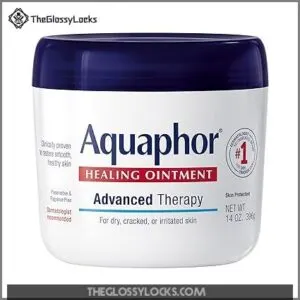
Beyond traditional exfoliants, Aquaphor Healing Ointment creates a protective barrier that prevents razor burn before it starts.
This multipurpose skin protectant contains petrolatum, provitamin B5, and glycerin that soothe irritated skin while locking in moisture.
You’ll find it particularly effective for post-shave care, as it keeps your skin hydrated and creates an ideal healing environment.
Apply a thin layer after shaving to prevent bumps and irritation, utilizing its water-free formula that won’t clog pores but provides lasting protection for sensitive, freshly-shaved skin, promoting a healthy and ideal healing environment.
Best For: Individuals with dry, sensitive, or irritated skin seeking a versatile and effective skincare solution.
- Provides a protective barrier to lock in moisture and enhance healing.
- Multipurpose use for minor cuts, burns, cracked skin, and post-shave care.
- Unscented and dermatologist-recommended for sensitive skin.
- Thick texture may feel greasy before absorption.
- Some users find the jar packaging less convenient than tubes.
- Expiration dates can sometimes be closer than expected.
3. CeraVe Moisturizing Cream for Dry Skin
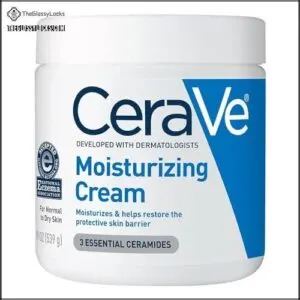
Among the heavyweights of post-shave care, CeraVe Moisturizing Cream delivers serious hydration punch.
This dermatologist-developed formula combines ceramides, hyaluronic acid, and MVE technology to restore your skin’s natural barrier after shaving trauma.
You’ll love how quickly it absorbs without leaving that greasy film that makes you feel like a glazed donut.
Apply it twice daily to razor-burned areas, but limit facial use to three days max, and enjoy the benefits of premium skincare at an affordable price, thanks to the incredible value offered by the 19-ounce tub, making it affordable for everyone with its incredible value.
Best For: Individuals with dry, sensitive, or eczema-prone skin seeking deep hydration and a restored skin barrier.
- Provides 24-hour hydration with a non-greasy, fast-absorbing formula.
- Contains ceramides and hyaluronic acid to restore and maintain skin barrier.
- Affordable due to its large size and long-lasting use.
- Tub packaging can be less hygienic compared to pump or tube options.
- May feel too rich for oily skin types.
- Requires limiting facial application to three consecutive days.
4. La Roche-Posay Cicaplast Balm B5
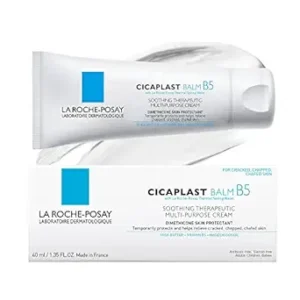
This therapeutic balm works like a protective shield for your freshly shaved skin.
You’ll get multi-purpose relief from razor burn, thanks to its combination of Vitamin B5 and sustainably sourced Shea Butter that restores your skin’s natural barrier.
The thick, white cream absorbs within 30 minutes without leaving sticky residue, though you might notice some initial greasiness.
It’s fragrance-free and gentle enough for sensitive skin, making it perfect for post-shave care.
A pea-sized amount goes a long way in soothing irritation.
Best For: Individuals with sensitive, irritated, or freshly shaved skin seeking multi-purpose relief and hydration.
- Gentle, fragrance-free formula suitable for sensitive skin.
- Absorbs fully within 30 minutes without leaving sticky residue.
- Effective in soothing razor burn and repairing the skin’s natural barrier.
- May feel greasy upon initial application.
- Best suited for nighttime use due to thick texture and white cast.
- Higher price point compared to some alternatives.
5. Cortizone 10 Anti-Itch Cream Aloe
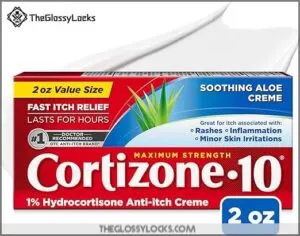
After dealing with the sting of razor burn, you’ll appreciate having Cortizone 10 Anti-Itch Cream with Aloe on standby.
This maximum-strength hydrocortisone cream delivers fast relief in under 10 minutes and keeps working for hours.
The added aloe vera soothes inflamed skin while the 1% hydrocortisone tackles inflammation head-on.
It’s fragrance-free and dye-free, making it perfect for sensitive post-shave skin.
Remember that dull razors tug at hairs, increasing irritation.
Keep this dermatologist-recommended cream in your medicine cabinet – it’s like having a fire extinguisher for razor burn emergencies.
Best For: Those seeking fast, long-lasting relief from itch and irritation caused by eczema, psoriasis, insect bites, and razor burn.
- Provides fast-acting and long-lasting relief in under 10 minutes.
- Soothes sensitive and irritated skin with added aloe vera.
- Fragrance-free and dye-free, suitable for sensitive skin.
- Not widely available in local drugstores, often requires online purchase.
- May not provide complete relief for severe skin conditions.
- Contains hydrocortisone, which some may be sensitive to over time.
6. Tend Skin Ingrown Hair Solution
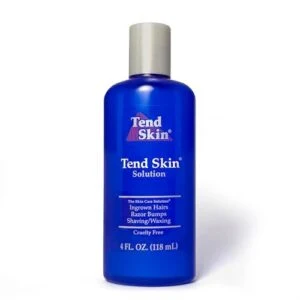 View On Amazon
View On Amazon Stubborn ingrown hairs getting you down?
Tend Skin Ingrown Hair Solution tackles those pesky bumps head-on.
This liquid formula works double duty—preventing new razor bumps while clearing existing ones.
You’ll apply it after shaving once your skin’s dry, then watch it absorb in seconds without leaving residue.
For active bumps, use it nightly regardless of your shaving schedule.
Once your skin clears up, dial back to daily post-shave application.
It’s pricey but delivers results that’ll make you wonder why you waited so long to find a solution for ingrown hairs.
Best For: Individuals struggling with ingrown hairs, razor bumps, or razor burn from shaving, waxing, or other hair removal methods.
- Reduces ingrown hairs, razor bumps, and redness effectively with consistent use.
- Quick-drying, lightweight formula that doesn’t leave residue or grease.
- Cruelty-free and suitable for sensitive skin, with long-lasting results.
- Expensive compared to similar products on the market.
- May cause slight dryness or flaking in some skin types.
- Inefficient bottle design can lead to product wastage.
7. iS CLINICAL Hydra Cool Serum
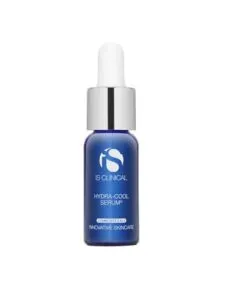 View On Amazon
View On Amazon While most serums focus on hydration alone, iS CLINICAL Hydra Cool Serum tackles razor burn with a unique cooling approach.
This lightweight formula combines hyaluronic acid with menthol for instant relief from post-shave irritation.
The Vitamin B5 helps repair your skin barrier while the serum’s antioxidants protect against further damage.
You’ll appreciate how quickly it absorbs without leaving residue, making it perfect for sensitive skin that needs both hydration and healing, though it’s pricier than drugstore options, users consistently return to this product after trying alternatives.
Best For: Sensitive, combination, or acne-prone skin seeking hydration, healing, and relief from irritation, including post-shave care.
- Higher price compared to similar products.
- Menthol may irritate very sensitive skin.
- Shipped with a dropper instead of the advertised pump dispenser.
- Soothes razor burn and reduces redness with cooling menthol.
- Hydrates and repairs skin with hyaluronic acid and Vitamin B5.
- Absorbs quickly without leaving residue.
Soothing Razor Burn
When razor burn strikes despite your best prevention efforts, you’ll need fast-acting remedies to calm the angry red bumps and burning sensation.
The right combination of anti-inflammatory ingredients and gentle care can transform irritated skin back to smooth comfort within days, using simple treatments you likely already have at home, with fast-acting remedies.
Applying Hydrocortisone Cream
When razor burn strikes, over-the-counter hydrocortisone cream becomes your skin’s best friend.
This anti-inflammatory powerhouse tackles itching and redness head-on, offering quick relief from shaving irritation.
Here’s how hydrocortisone transforms your post-shave experience:
- Reduces angry inflammation within hours of application
- Stops relentless itching that makes you want to scratch constantly
- Calms red, irritated skin back to its normal appearance
- Provides targeted relief exactly where you need it most
- Works fast when other remedies fall short
Apply a thin layer of 0.5% or 1% hydrocortisone cream directly to affected areas.
Use sparingly – a little goes a long way.
Limit facial application to three days and body application to one week maximum.
Prolonged use can actually weaken your skin barrier, creating more problems than it solves.
To prevent future irritation, consider alcohol-free moisturizers after shaving.
Start with the lowest concentration first.
If razor burn doesn’t improve within a week, consult your healthcare provider.
They might recommend prescription-strength options or investigate underlying skin conditions causing persistent irritation.
Remember: hydrocortisone treats symptoms, not causes.
Pair it with better shaving techniques for lasting results.
Using Aloe Vera and Coconut Oil
Both aloe vera and coconut oil offer powerful relief for razor burn through their natural healing properties.
Aloe benefits include cooling inflammation and speeding recovery, while coconut properties provide antimicrobial protection.
You can find various aloe products for different skin needs.
For effective application methods, apply pure aloe gel first, then seal with coconut oil.
These DIY remedies work best as postshave care, creating a protective barrier that soothes shaving irritation relief naturally.
Benefits of Oatmeal Baths and Masks
Oatmeal’s anti-inflammatory properties make it your skin’s best friend after shaving mishaps.
Creating an oatmeal bath involves adding finely ground oats to warm water, providing protective and moisturizing benefits explained by research.
For targeted relief, try mask recipes using cooled oatmeal porridge applied directly to irritated areas, offering a natural approach to gentle soothing skin care without harsh chemicals.
Tea Tree Oil for Inflammation
Beyond soothing oats, tea tree oil offers powerful antimicrobial properties that calm razor burn inflammation. This natural antiseptic helps in preventing razor bumps while reducing skin reactions.
Always dilute properly before applying:
- Mix 2-3 drops with carrier oil like coconut or jojoba
- Test on small skin patch first
- Apply gently to affected areas twice daily
Consider alternative oils if sensitivity occurs, to ensure the best results for your skin, using natural remedies.
Razor Burn Treatment Tips
When razor burn strikes despite your best prevention efforts, you’ll need proven treatment strategies that address both immediate relief and long-term skin health.
When your best shaving efforts fall short, smart treatment strategies restore comfort and prevent future irritation.
These expert-backed methods focus on three key areas: proper shaving technique, consistent exfoliation habits, and selecting the right tools for your skin type to prevent future irritation.
Shaving in The Direction of Hair Growth
After soothing razor burn, rethink your shaving technique.
Always shave in the direction of hair growth.
This reduces pressure on the skin, minimizes irritation, and keeps ingrown hair removal in check.
Adjust your razor angle for the best glide, favoring short strokes to prevent razor bumps.
| Shaving Tips | Why It Works | Avoid These |
|---|---|---|
| Shave with hair growth | Prevents ingrown hair and irritation | Going against hair growth |
| Use light pressure | Reduces skin sensitivity factors | Pressing too hard |
| Keep skin wet | Enhances glide and razor angle impact | Shaving dry skin |
| Use sharp blades | Guarantees smooth, precise hair removal | Using dull razors |
| Rinse blades regularly | Maintains perfect shaving direction | Skipping blade cleaning |
Exfoliating Regularly for Skin Health
Making exfoliation a weekly habit keeps your skin smooth and bump-free between shaves.
Choose gentle exfoliants like salicylic acid body washes or sugar scrubs based on your skin sensitivity.
Regular skin exfoliation removes dead cells that trap hair, preventing razor burn and skin irritation.
Post-exfoliation care with moisturizer maximizes exfoliation benefits for healthier skin.
Choosing The Right Razor for Sensitive Skin
Sharp razor blades make all the difference for sensitive skin.
Single-blade safety razors cause less irritation than multi-blade cartridges, though they require practice.
Electric razors with hypoallergenic materials offer the gentlest option.
Choose weighted handles for better control and less pressure.
Regular razor maintenance keeps blades sharp, reducing dragging that triggers razor burn.
For best results, consider how hair density impacts blade choice, and use a weighted handle for better control.
Frequently Asked Questions (FAQs)
Does exfoliating help prevent razor burn?
Did you know exfoliating can cut razor burn risk by 50%?
By removing dead skin, you clear a smoother path for your razor.
Just remember, don’t overdo it—gently exfoliate beforehand and never on irritated skin.
How do you prevent razor burn?
Use a sharp blade and moisturizing shave cream on wet skin. Shave with hair growth using light strokes. Don’t re-shave areas. Apply fragrance-free moisturizer afterward. Allow recovery time between shaves.
What can I use to exfoliate my skin before shaving?
You can exfoliate with a warm, wet washcloth using gentle circular motions, or try a moisturizing sugar scrub.
Chemical exfoliants like salicylic acid body wash also work well to remove dead skin cells effectively.
How to exfoliate down there before shaving?
Gently cleanse the area with warm water first.
Use a soft washcloth in circular motions or try a mild sugar scrub.
You can also apply a gentle chemical exfoliant containing salicylic acid for smoother results.
How often should I exfoliate between shaves?
Ironically, less really is more in the context of exfoliation frequency.
You’ll want to exfoliate 2-3 times weekly between shaves, allowing your skin time to recover while maintaining that smooth, bump-free surface you’re after.
Can I exfoliate immediately after getting razor burn?
No, don’t exfoliate immediately after razor burn.
Your skin needs time to heal first. Wait until the irritation subsides completely before resuming exfoliation.
As scrubbing inflamed skin will worsen the condition and delay recovery.
Whats the difference between AHA and BHA exfoliants?
Here’s the twist: AHA exfoliants focus on your skin’s surface, brightening and smoothing by dissolving dead cells.
BHA dives deeper into pores, unclogging oil and debris, making it great for oily or acne-prone skin, and can be seen as a great option.
Should I exfoliate differently for face vs body?
Yes, you should adjust your exfoliation approach.
Your face needs gentler treatment with milder chemical exfoliants or soft cloths.
Your body can handle stronger scrubs and more frequent exfoliation since the skin’s thicker.
When is the best time to exfoliate during shower?
Exfoliate after you’ve spent time in warm water but before you shave.
The heat softens your skin and opens pores, making dead skin removal easier and more effective for smoother shaving.
Conclusion
Nobody wants to look like they wrestled with a cheese grater after shaving.
When you exfoliate to prevent razor burn, you’re investing in skin that feels smooth instead of angry.
Regular exfoliation removes dead cells that trap hairs and cause irritation.
Choose chemical or physical exfoliants based on your skin’s needs, and always exfoliate before shaving, not after.
Your skin will thank you with fewer bumps, less redness, and a comfortable shave every time.

